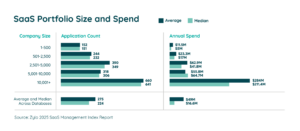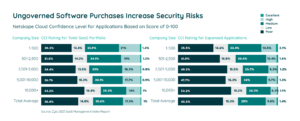
Zoom License Cost 2026: Which Plan Offers the Best Value for Your…
Table of Contents ToggleUnderstanding the SaaS LandscapeThe Evolution of SaaSSaaS Market...
Back
Back
Search for Keywords...
Blog

Table of Contents
The SaaS landscape has forever changed how businesses operate—improving workflows, collaboration, and project execution. Understanding how SaaS has evolved, where it’s going, and the impact to IT, Software Asset Management, and Procurement teams is critical to managing it properly.
SaaS models have become the foundation of how businesses obtain, use, and scale software. Instead of relying on locally installed programs, companies now access their applications via cloud-based platforms, which presents greater flexibility, lower costs upfront, and quicker implementation.
This tech evolution has redefined both how software is delivered and how teams manage spending, security, governance, and organizational growth. The SaaS landscape was “emerging” years ago, and it’s now embedded into most modern business processes.
According to the 2025 SaaS Management Index, the average organization now manages 275 applications, and for some businesses, that number continues to grow. But IT is no longer responsible for acquiring all software for the business.

Today, every team—from marketing and engineering to HR and finance—buys 84% of applications within the average organization. While this helps fulfill a need in the moment, decentralized purchasing creates risk. As a result, it requires a strategic approach to manage.

Cloud software adoption has skyrocketed in the past decade or so. As recently as 2008, most businesses used on-premises deployment, which has changed dramatically.
In addition, a Software Advice report analyzed market trends and found that more companies than ever are moving to the cloud. The report surveyed a number of businesses on their preferences and found that between 2008 and 2014, their preferences changed significantly. In 2008, over 80% of companies preferred on-premises tools. By 2014, though, that preference almost completely reversed, and now more than 80% of companies prefer cloud-based deployment.
For procurement leaders, the migration from on-premises to cloud is just one of the many factors that are changing how enterprise organizations purchase (or subscribe to) software and SaaS applications.
The global SaaS market is currently valued at over $260B and is expected to exceed $1.131B by 2032. Much of this growth is fueled by the move to remote and hybrid work, the demand for digital accessibility, and the rising popularity of AI-powered tools.
Enterprise businesses are especially active in this expansion, with many companies managing hundreds or thousands of SaaS applications at one time. As the market continues to grow, so too does the need for compliance, visibility, and governance.
Many of the world’s leading SaaS companies have become household names. A few of the more widely used platforms across industries include:
 The popularity of specific SaaS applications can be measured by those commonly expenseed by employees. Often, these platforms provide essential business functionality, including communication, collaboration, CRM, and analytics. According to Zylo’s data, the following applications consistently rank among the top-expensed SaaS tools:
The popularity of specific SaaS applications can be measured by those commonly expenseed by employees. Often, these platforms provide essential business functionality, including communication, collaboration, CRM, and analytics. According to Zylo’s data, the following applications consistently rank among the top-expensed SaaS tools:
Artificial intelligence continues to shape SaaS trends. Intelligent automation, predictive analytics, and the like make AI an exceptional tool for streamlining workflows, improving user experience, and driving better decision-making.
Generative AI is especially influencing how users interact with SaaS platforms. Many vendors now offer AI-powered assistants that summarize reports, suggest actions, or even write emails and code.
This transformation is not limited to end-user tools, fortunately. AI is also enhancing how companies manage their SaaS portfolios by powering smarter license optimization, spend forecasting, and risk detection.
The 2024 SaaS Management Index reports that organizations using AI to assist in SaaS governance are seeing faster response times, fairer vendor negotiations, and enhanced cost visibility.
The SaaS landscape offers several pricing models to address customer needs. Understanding the differences between them is essential for IT, procurement, and SAM teams evaluating new tools.
Free or freemium models are a popular choice among startups and product-led growth (PLG) companies. Users get access to core features at no cost, with options to upgrade to paid tiers as their needs expand. This strategy helps strengthen adoption while reducing sales friction.
Also known as consumption-based pricing, this model charges customers based on how much they use the platform, which is commonly measured by API calls, storage, or credits.
According to Zylo’s overview of consumption-based pricing, these models offer more flexibility for growing teams, but can also introduce budgeting challenges if usage spikes unexpectedly.
Most enterprise SaaS platforms still use predictable, recurring revenue from subscription plans, which are typically billed monthly or annually. These models provide stable pricing but can lead to overpayment if licenses are underutilized.
Utilizing tools for license management is a must to avoid waste and right-size contracts based on actual usage.
Hybrid pricing models are gaining traction, as well, like flat-rate base fees that come with usage-based overages. Some companies are experimenting with value-based pricing, which ties the cost to the results delivered. Others are bundling a selection of tools together to provide broader solutions at a discount.
As the SaaS landscape continues to change, several trends are reshaping how businesses approach software acquisition and management. These trends, including enhanced security measures, the rise of micro-SaaS solutions, and the increasing focus on sustainability, are setting the stage for a new phase of SaaS innovation.
As SaaS adoption increases, organizations are placing more emphasis on security and compliance. IT and governance departments are being asked to secure far more apps than before, including user access control and data residency requirements.
Modern strategies for addressing the challenge include single sign-on, multi-factor authentication (MFA), and the use of governance and risk mitigation tools to keep track of usage, permissions, and vulnerabilities.
Micro-SaaS solutions are niche tools that solve very specific business problems. These lightweight applications tend to serve a limited user base but also offer extensive functionality within a narrow scope. This trend enables greater agility but can lead to tool sprawl if not carefully managed.
DaaS enables users to access curated data collections through APIs or cloud-based platforms, which removes the need to manage or store large datasets internally. These services are ideal for organizations that depend on real-time insights, especially when it comes to customer behavior, AI training models, or operational analytics.
White-label SaaS tools make it easier for businesses to rebrand and customize third-party applications. This approach is popular among service-based businesses and agencies that want to deliver digital products without building their own software from the ground up.
Sustainability has become a priority in the SaaS industry. Companies are optimizing their infrastructure for energy efficiency and making carbon data available to enterprise clients. Procurement and IT teams that evaluate vendors are starting to weigh sustainability alongside performance and cost.
The rise of SaaS and evolution of the landscape demands that software acquisition and management be shared across several departments. Though procurement is typically in charge of purchasing decisions, IT and software asset management (SAM) teams are now essential to the SaaS lifecycle.
A cross-functional approach like this calls for close collaboration between teams, better data sharing, and more sophisticated tools. Without an organized software system, stakeholders struggle to gain full visibility into the company’s SaaS stack.
Top organizations are investing in SaaS Management Platforms that align these roles through shared dashboards, real-time analytics, and automated workflows for contract renewal, license reclamation, and vendor reviews. When each relevant department works together effectively, companies can reduce budgetary waste, increase software value, and yield better alignment between technology and business goals.
The role of IT is growing in both complexity and importance as SaaS and other cloud programs become commonplace in business operations. Because of this shift, IT has become focused on driving better business outcomes in addition to providing technical support functions.
Here are key ways IT’s role will continue to evolve:
Organizations now use far more SaaS tools than they did in the past. As such, IT departments need to maintain visibility across an expanding software landscape. Without that visibility, IT teams struggle to track software usage, ensure legal compliance, and prevent wasted spend.
By using a SaaS Management Platform, IT gets access to real-time data and the ability to manage renewals and optimize usage with ease.
License management is essential as companies move toward more subscription-based and usage-based tools. IT must ensure that the organization isn’t overpaying for unused licenses or violating any terms by over-deploying software. This responsibility calls for real-time monitoring and proactive contract management to ensure licensing remains aligned with business needs.
A growing volume of SaaS applications means an increased risk of data security issues. In fact, Zylo data shows that 51% of the apps in the average company’s portfolio have low or poor risk scores.
IT teams need to ensure that each tool is properly integrated into the company’s security infrastructure. This includes setting strict access controls, managing data privacy, and using tools to monitor vulnerabilities. Companies with lackluster security risk exposing sensitive data or costly data breaches.

As SaaS tools become more diverse and complex, the role software asset management teams play becomes even more important. In addition to tracking licenses, SAM now helps organizations manage SaaS portfolios to enhance value and reduce risk.
Being ready for an audit is one of the key responsibilities of SAM teams. With the increase in SaaS usage, businesses are more likely to deal with software audits as vendors aim to enforce compliance with contract terms. SAM teams are in charge of making sure a company’s software usage data is organized to simplify the audit process.
SAM teams also need to focus on license positioning to ensure software contracts and licenses match the organization’s current needs. This process involves looking at the company’s SaaS ecosystem through the lens of strategy and assessing whether current tools still meet their intended purpose.
Avoiding risk is central to a SAM team’s role. Ensuring contract compliance and alignment with usage terms helps reduce the risk of costly fines and potential legal issues. Teams also need to keep an eye on developing risks, such as data breaches or compliance issues, and then work proactively with InfoSec to address them.
SaaS procurement is both transactional and strategic. In addition to acquiring new software, procurement must also ensure it delivers value and supports the organization’s goals.
Here are three ways procurement’s role will continue to evolve with the SaaS landscape:
Because SaaS is critical to running the business, procurement’s influence will continue to grow. Teams will take a more active role in negotiating contract terms, managing renewals, and making sure new tools align with the organization’s overarching strategy. This includes working with SAM and IT professionals to understand the current software ecosystem.
Procurement teams need to enhance their understanding of SaaS, cloud-based tech, and licensing options. As contracts become more complicated, procurement professionals must be better versed in pricing structures, negotiation tactics, and software compliance. Expertise will help enable informed decision-making that supports a company’s digital transformation efforts.
In the past, Procurement’s success was measured by its ability to secure the lowest price. Now, the focus has shifted toward value creation.
Procurement teams need to quantify savings opportunities by identifying unused licenses, consolidating platforms, and reducing redundancies. In addition, they will be responsible for analyzing the ROI of SaaS investments to make sure the software portfolio contributes to the company’s long-term success.
As SaaS companies scale, they face several common challenges, including:
Looking ahead, the SaaS landscape will keep evolving. A few key trends are expected to shape the industry, including:
Companies that manage their software portfolios with precision see a significant return on their investment. When IT, SAM, and Procurement teams work closely together, they’re more capable of optimizing SaaS spend, reducing risk, and driving business value.
With Zylo, you can manage software assets more efficiently, streamline license compliance, and ensure that every software decision aligns with organizational goals.
Ready to manage, optimize, and govern your SaaS? Explore how Zylo can help you gain better visibility into your software portfolio, reduce waste, and ensure compliance.

Table of Contents ToggleUnderstanding the SaaS LandscapeThe Evolution of SaaSSaaS Market...

Table of Contents ToggleUnderstanding the SaaS LandscapeThe Evolution of SaaSSaaS Market...

Table of Contents ToggleKey Themes That Shaped SaaS Management in 20251....

Table of Contents ToggleUnderstanding the SaaS LandscapeThe Evolution of SaaSSaaS Market...
| Cookie | Duration | Description |
|---|---|---|
| cookielawinfo-checkbox-analytics | 11 months | This cookie is set by GDPR Cookie Consent plugin. The cookie is used to store the user consent for the cookies in the category "Analytics". |
| cookielawinfo-checkbox-functional | 11 months | The cookie is set by GDPR cookie consent to record the user consent for the cookies in the category "Functional". |
| cookielawinfo-checkbox-necessary | 11 months | This cookie is set by GDPR Cookie Consent plugin. The cookies is used to store the user consent for the cookies in the category "Necessary". |
| cookielawinfo-checkbox-others | 11 months | This cookie is set by GDPR Cookie Consent plugin. The cookie is used to store the user consent for the cookies in the category "Other. |
| cookielawinfo-checkbox-performance | 11 months | This cookie is set by GDPR Cookie Consent plugin. The cookie is used to store the user consent for the cookies in the category "Performance". |
| viewed_cookie_policy | 11 months | The cookie is set by the GDPR Cookie Consent plugin and is used to store whether or not user has consented to the use of cookies. It does not store any personal data. |
